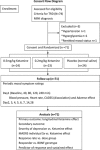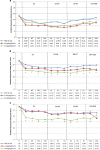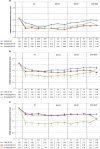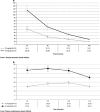Dose-Related Effects of Adjunctive Ketamine in Taiwanese Patients with Treatment-Resistant Depression
- PMID: 28492279
- PMCID: PMC5686503
- DOI: 10.1038/npp.2017.94
Dose-Related Effects of Adjunctive Ketamine in Taiwanese Patients with Treatment-Resistant Depression
Erratum in
-
Correction: Dose-Related Effects of Adjunctive Ketamine in Taiwanese Patients with Treatment-Resistant Depression.Neuropsychopharmacology. 2019 Feb;44(3):655-656. doi: 10.1038/s41386-018-0253-z. Neuropsychopharmacology. 2019. PMID: 30487654 Free PMC article.
Abstract
The antidepressant effects of ketamine are thought to depend on brain-derived neurotrophic factor (BDNF) genotype and dose. The purpose of this study was to characterize the dose-related antidepressant effects of ketamine in patients with treatment-resistant depression drawn from a Chinese population predominately possessing lower activity BDNF genotypes (Val/Met, Met/Met). We conducted a double-blind, randomized, parallel-group, placebo-controlled trial of a single ketamine infusion (saline, 0.2 mg/kg, 0.5 mg/kg). Patients (N=71; BDNF genotype: Val/Val (N=12, 17%), Val/Met (N=40, 56.3%), and Met/Met (N=19, 26.8%)) received mood ratings before infusion, after infusion, and for the subsequent 14 days. Plasma ketamine levels and BDNF genotypes were assessed. This study found a significant dose-related ketamine effect on scores on the Hamilton Depression Rating Scale (HAMD). The responder analysis (>50% reduction from baseline HAMD on at least 2 days between days 2 and 5) also revealed a significant dose-related effect (saline: 12.5%, 0.2 mg/kg: 39.1%; 0.5 mg/kg: 45.8%). This is the first report to our knowledge to demonstrate the dose-related efficacy of R/S-ketamine for treatment-resistant depression and the first to characterize ketamine effects in a genotyped Chinese population in which most (83%) patients possessed at least one copy of the lower functioning Met allele of the BDNF gene.
Figures





References
-
- Berman RM, Cappiello A, Anand A, Oren DA, Heninger GR, Charney DS et al (2000). Antidepressant effects of ketamine in depressed patients. Biol Psychiatry 47: 351–354. - PubMed
-
- Chen ZY, Patel PD, Sant G, Meng CX, Teng KK, Hempstead BL et al (2004). Variant brain-derived neurotrophic factor (BDNF) (Met66) alters the intracellular trafficking and activity-dependent secretion of wild-type BDNF in neurosecretory cells and cortical neurons. J Neurosci 24: 4401–4411. - PMC - PubMed
-
- Choi MJ, Kang RH, Lim SW, Oh KS, Lee MS (2006). Brain-derived neurotrophic factor gene polymorphism (Val66Met) and citalopram response in major depressive disorder. Brain Res 1118: 176–182. - PubMed
Publication types
MeSH terms
Substances
Grants and funding
LinkOut - more resources
Full Text Sources
Other Literature Sources
Medical
Miscellaneous

